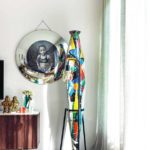From London to Herne Bay: A British-Kiwi couple learn to love the slow life after returning to Aotearoa
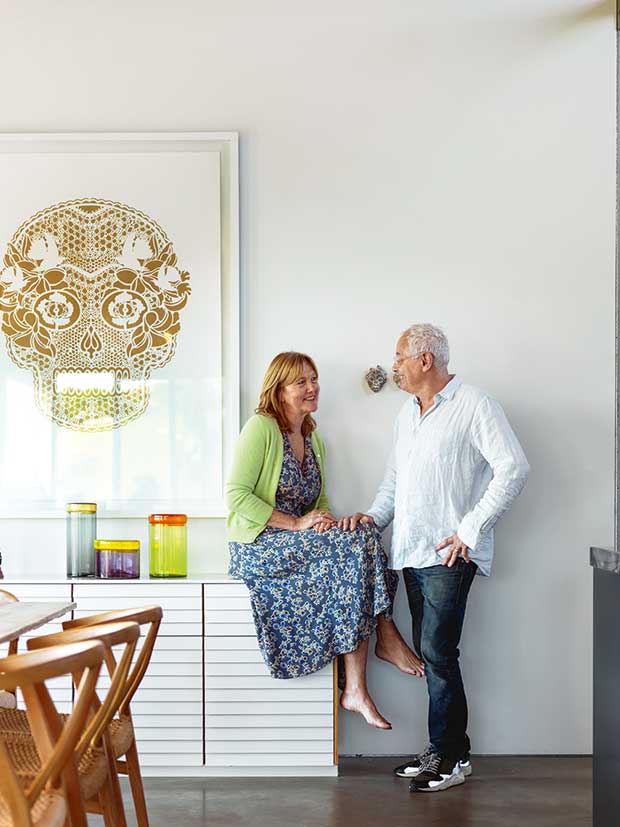
A one-off print by Haus of Flox hangs above the cabinet. The couple enjoys a flexible work schedule, and Megan often heads up to the beach on Thursdays for an extra-long weekend. The coloured glass containers are from Ron’s design store, Bob & Friends.
This couple spent many years among the glitterati in London’s fast lane. Now Auckland-based, they’re learning the joy of slow(ish) motion.
Words: Claire McCall Photos: Jane Ussher
It’s called the most Instagrammable restaurant in the world. Imagine an emporium of fairy lights with white roses on the ceiling, blue-gingham tablecloths and beautiful people who come to dine on fresh, rustic fare. But the woman who gave her name to what became a chain of romantic eateries in the well-to-do suburbs of west London is nonplussed. She calls it the past.
Megan Redel remembers the night she decided to turn her antique store on the King’s Road into the eponymous Megan’s. She was alone in the shop at 3am assessing damage. “The shop had been broken into again,” she explains. “My business partner had just passed away, and it was like a bolt: I’d open a restaurant here instead.”
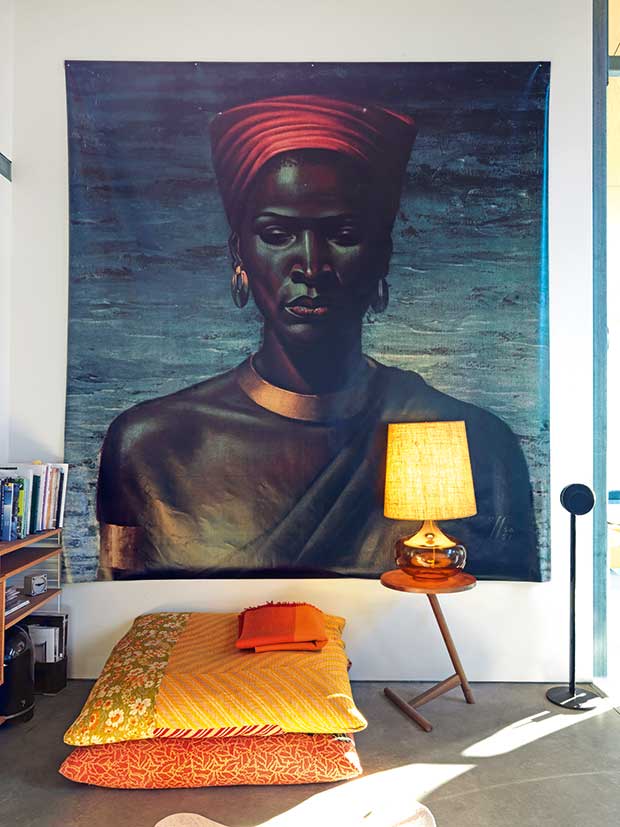
An over-sized Tretchikoff print is a focal point in the television area at Megan and Ron Redel’s beach home at Mangawhai. Megan made the floor cushions herself and assembled the lamp on the table from a vintage bottle and shade.
It was a brave move for the expat Kiwi who left New Zealand as a teenager. It wasn’t her first. Megan was a “Bethany” baby born to a young, single mother in a hospital run by The Salvation Army. “It was a troubled time for my mother, but we stayed together; I have six siblings, and we are all close.”
At 18, she was married and traveled with her husband to London. There, her accounting skills landed her a dream job working in the record industry with people like Sir George Martin (producer of The Beatles) and Blondie. “It was incredible: I misbehaved for two years.”
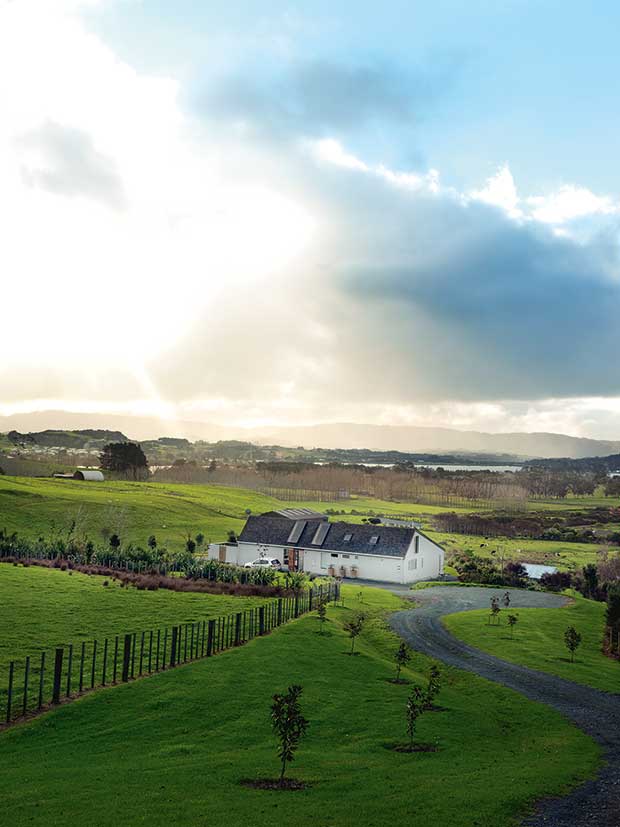
White magnolia trees are planted along the drive to the house.
In her next role — for Eton-educated interior designer Nicky Haslam — she was given the “ridiculous” title of financial controller. Haslam was a chimerical socialite who partied with Hollywood princes and hung out with London’s high society. He sang cabaret, wrote for The Spectator, and in his autobiographical memoir claimed to have had an affair with Princess Margaret’s husband, Antony Armstrong-Jones.
Megan tried to keep him “safe” (financially, that is) while she learnt the business of antiques. As she sold to people with unlimited budgets, she became captivated by the elegance of London and began a 20-year love affair with decorative furniture and textiles.
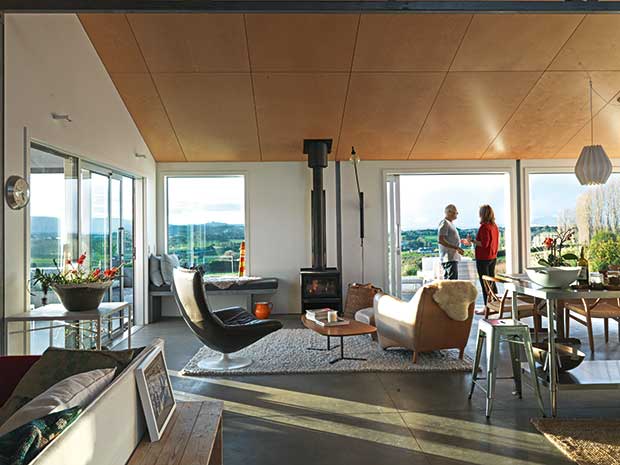
The studio of sculptor and designer Carin Wilson inspired the barn-style home. A mid-century chair (on the left) bought in London, and a Balzac chair by Matthew Hilton from Bob & Friends are grouped around the fireplace. “Although the concrete floors retain heat, we like to use the wood burner every day in winter,” says Ron.
That ended the night of the umpteenth burglary.
When Ron Redel met Megan in 1988, she was still running her antiques business and trying to bring up Selena, her four-year-old daughter, on her own. He was producing commercials and needed a part-time bookkeeper. “We stumbled over each other, and the rest is history,” he says.
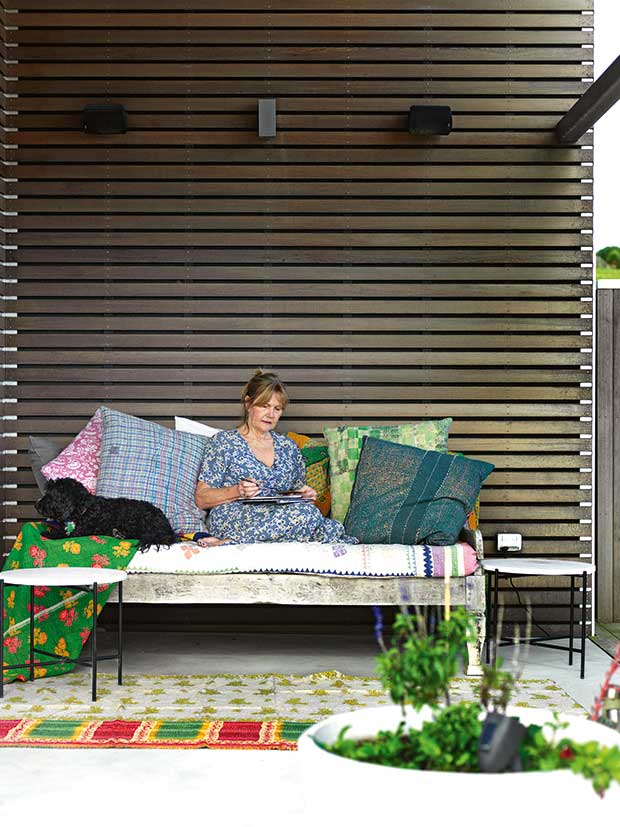
The covered outdoor deck is lined in cedar and is a great place to relax.
At the Herne Bay home the couple share today, Ron’s creative stamp predominates. A Steve McQueen film poster in the entrance hall is the backdrop to a black/white coconut chair, and bulbous glass vessels are bold forms on the kitchen windowsill. A George Nelson bubble pendant hovers above the dining table. It’s the classic advertising buff’s hang-out. Yet Ron’s road to the industry was a bumpy one.
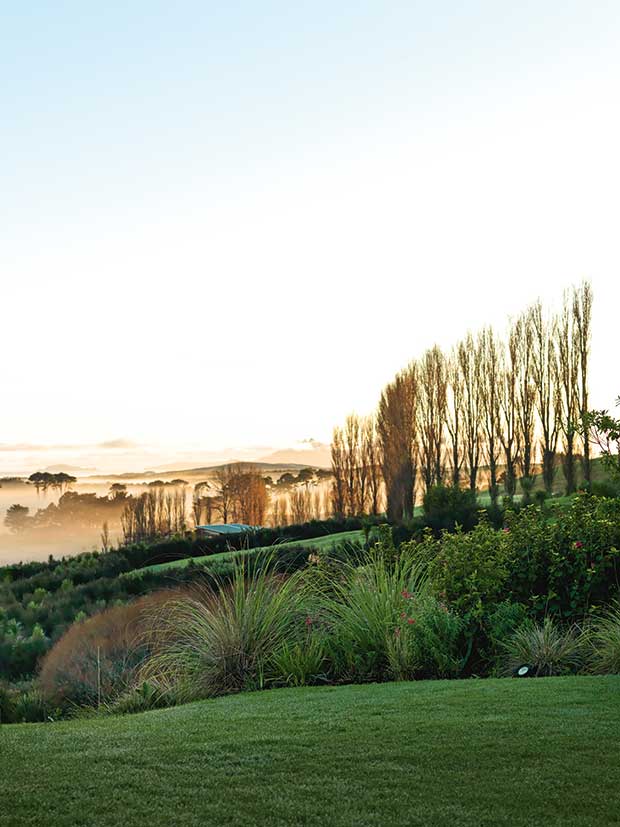
The one-hectare Mangawhai property has views to the Hen and Chicken Islands. Megan planted the land with easy-care natives and olives, which Ron bottles in big jars. “The fruit from a single tree made six one-litre jars.”
His parents were refugees, German-Polish Jews who fled to the safety of London in the 1930s and settled in Swiss Cottage. (Later they traveled to Belgium once a year so Ron’s father could nosh out on nostalgia — the excellent coffee, gefilte fish and braided pastries of his past.) Ron grew up in a multi-storey home where each family shared a floor and, as a young boy, he would sneak downstairs to watch his neighbour draw for hours.
“That was Robert Ellis, who did the cartoon opening titles for The Pink Panther movies. It was because of him that I wanted to do art.”
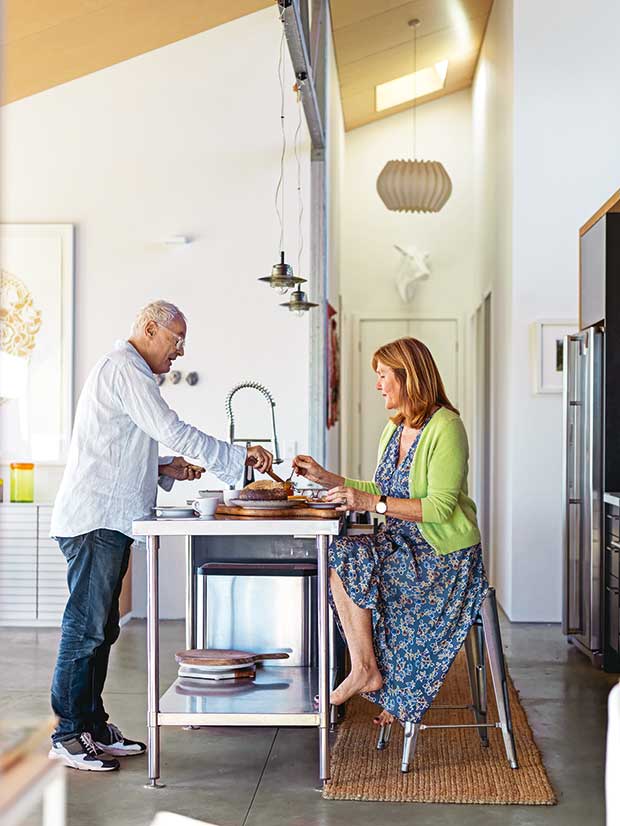
A commercial kitchen bench becomes the hub of weekend industry with Chicken Marbella and lots of curries on the menu.
At 16, he was invited to attend the West Surrey College of Art & Design where he expected to begin creating the wildly expressive prints of his time.
“Instead, we spent the first week learning to weave. Initially, I was furious.” So when he developed a passion for woven textiles, the long-haired, Gitanes-smoking youth was taken by surprise. “I just loved it.”
His ideas were rebellious and far removed from the old-fashioned tea towels the school was asking him to make, and he was always in trouble. “When I ended up in a magazine feature about contemporary craft alongside two of my tutors, it was a validation.”
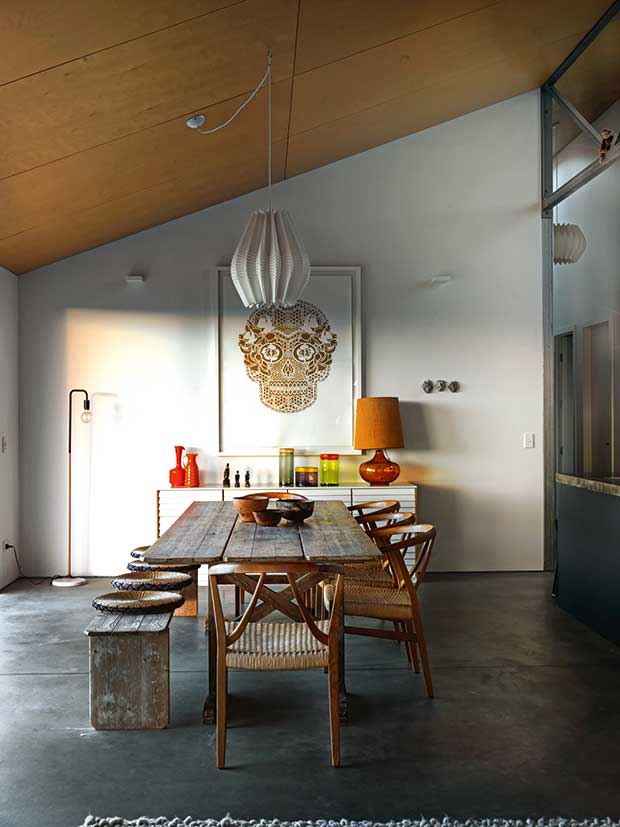
A cabinetmaker converted old French cheese boards, bought at Vitrine in Auckland, into tops for the family dining table and bench seat. A Ciara O’Neill pendant from Bob & Friends and a simple standard lamp that Ron found at Kmart provide the ambient lighting.
Ron finds it hard to say what caused him to abandon his master’s in textile art and his Swedish loom. “One day I woke up and thought, ‘I want to make films.’” Easier said than done. He couldn’t get a job in movies without a union ticket. He couldn’t get a union ticket without a relevant role. Catch 22.
Working as a stagehand at Raymond Revuebar, a theatre and strip club billed as “The World Centre of Erotic Entertainment”, became his ticket. “I spent my days in the family jewellery business and nights at the theatre.”
He got his break after nine months by persistently hounding a film producer until he hired him as an assistant editor. Such persistence saw Ron work his way up the credits list fast. “I directed commercials for three years; I wasn’t good enough to be a film director,” he says. “I didn’t have the clear, ruthless vision. Great film directors can’t afford to be Mr Nice Guy.”
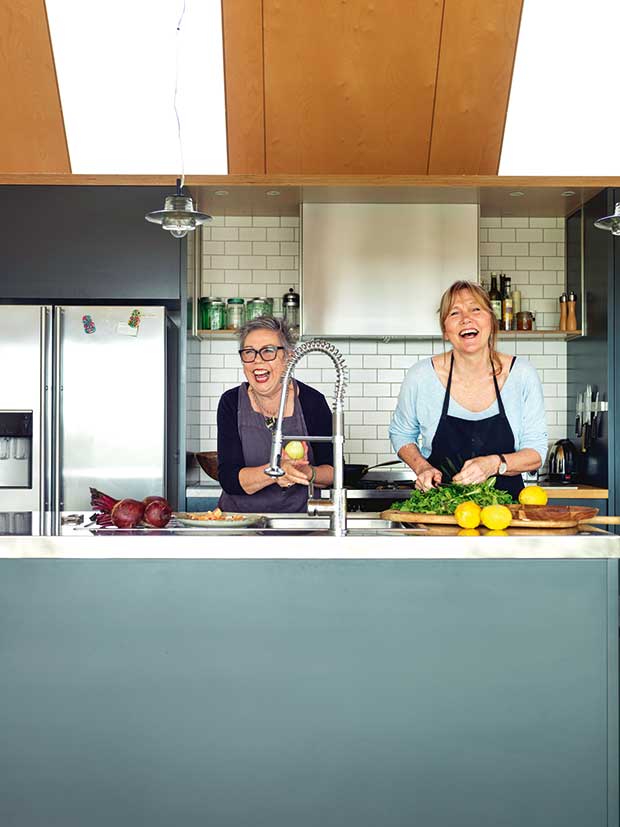
Megan and her Mangawhai-based friend Mandy Thomsett-Taylor run a catering company with a focus on grazing platters. They keep the food casual and the preparation fun.
It wasn’t a wrong move into advertisements — in fact, he went on to produce them for three decades. The experience was a rollercoaster ride with successes and enough failures to keep him honest. Over the years Megan and Ron had two children (Charlotte and Johnny), developed properties, and enjoyed living in “the city of beautiful idiots and brilliant lunatics”. (Thanks, Oscar Wilde.)
But in 2009 the gloss was wearing thin. The restaurant was exhausting and the fallout from the GFC was still biting. Charlotte was a teenager ready for adventure, and Ron’s mother had just died. So when Megan found a buyer for the business, they took another leap of faith.
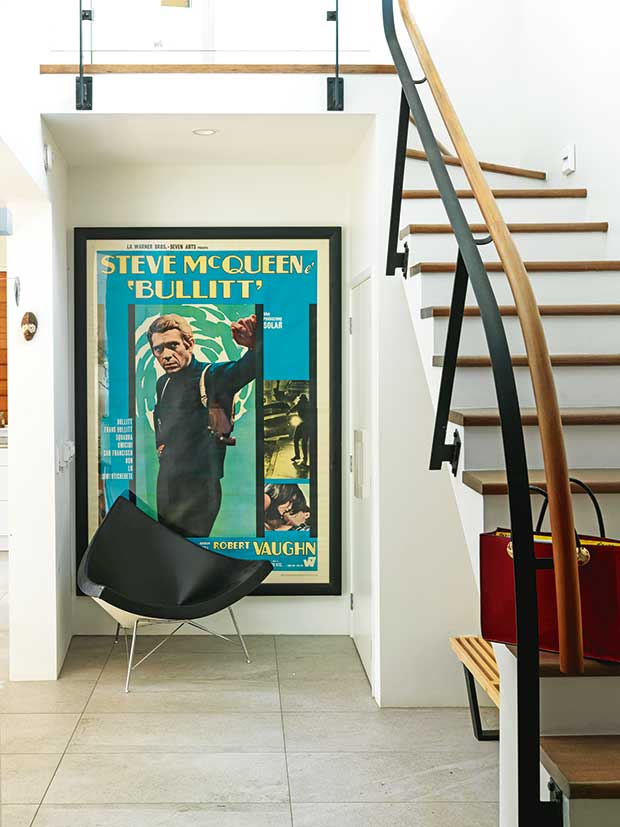
An original film poster and coconut chair by Vitra in the entrance hall at Megan and Ron’s home in Westmere; (right) a tall mosaic vase by Malcolm Temple has been in Ron’s possession for 30 years but he only just imported from Britain. It stands in front of a silver-framed portrait called Misplaced Youth by MJP Binks that Ron gave Megan as a birthday present.
“We rented out our house in Hampton Court and told ourselves we would come to New Zealand for a year,” says Megan. Even then she knew that was a lie.
Now well settled into Antipodean life, the couple spends time between Auckland and the holiday home in Mangawhai. Megan works as a consultant to an events company, which includes booking the chef talent from New Zealand and overseas for the Auckland Food Show. She also recently launched a catering business, Sisters Kitchen, with a friend.
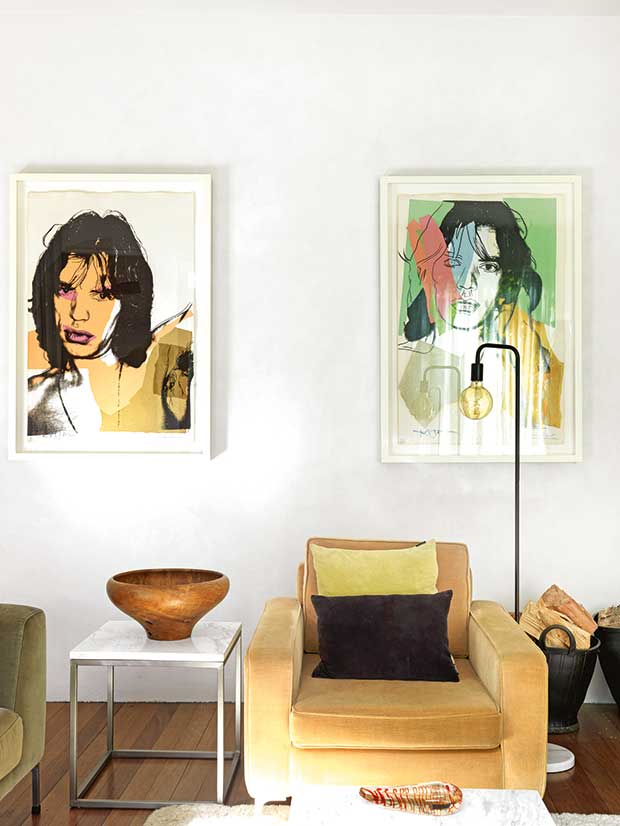
A fan of Mick Jagger, Ron bought these Andy Warhol prints (below) on his first trip to New York in 1977.
“We make platters and dinners for corporate functions and private clients and are driven to enjoy it. We don’t want to change the world,” she says.
Ron has branched into retail, which allows him to explore his obsession with interior design. He set up Bob & Friends, a curated collection of contemporary European furniture, homewares and things he likes, which he sells from a Ponsonby Road villa. He is hoping to encourage New Zealanders to be braver in their décor choices, to move away from the monochromatic.
“Although our look is very different from what the local market has come to expect, the business has gradually grown.” He enjoys the selling process and is equally at home expounding the delights of a Matthew Hilton sofa as a Herb Lester guidebook to clandestine London.
Perhaps then, he can be forgiven for filling this place and the one at Mangawhai — a barn-like structure designed by sculptor Carin Wilson — with his finds. Collections of vintage robots, architecture and art books, bowls from Kmart, and jars and jars of homemade preserves slowly encroach on the spaces.
“It has little to do with me,” says Megan. “I like the ability to offload that shell on your back and move on.”
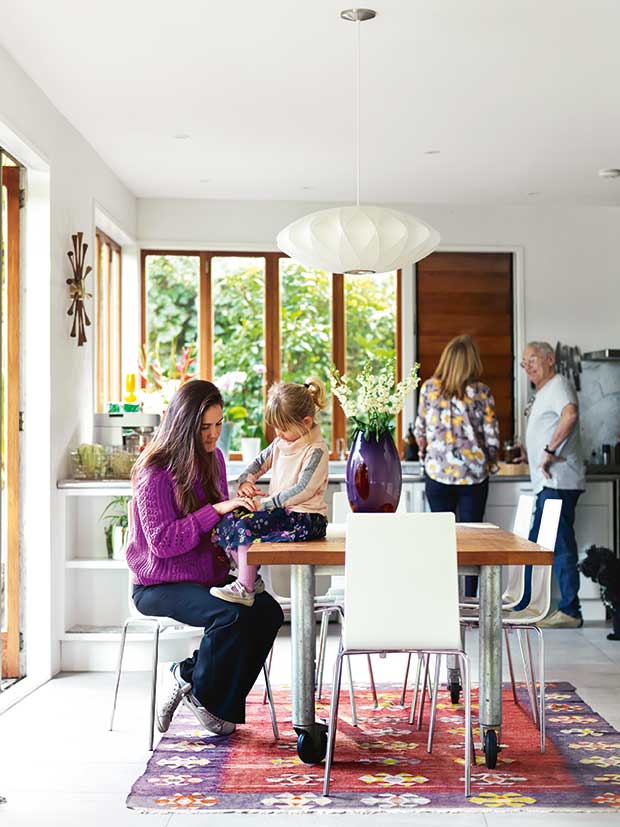
Leni (4), the couple’s only grandchild, is a regular visitor, especially when her mother Selena is busy managing events such as the Baby Show.
Moving on is exactly what the Redels did when they closed the door on both their London businesses and headed for Aotearoa. “We’re still working out how to live for the next 10 years.”
One thing’s for sure: the pace is slower. They have time to take in a show or an exhibition, pop out to the spice stores on Sandringham Road, bottle olives and chew the breeze with two children currently in residence.
“I might miss walking down Portobello Road on a Saturday morning. But I’m never bored, and I’ll often send friends a photo of my weekend stroll along the beach,” says Ron.
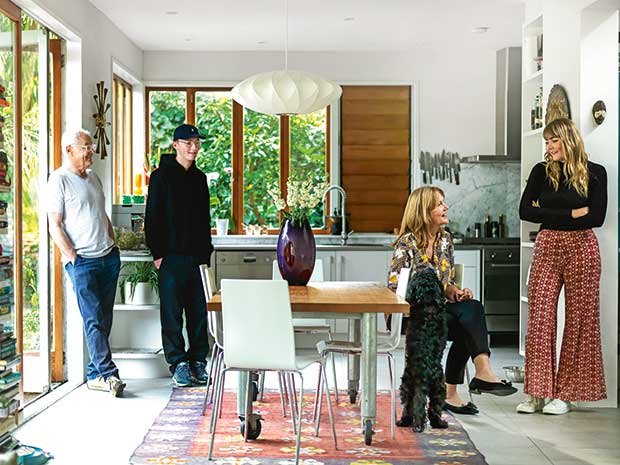
Ron, Johnny (a chef at Karangahape Road eatery Gemmayze Street), Megan with spoodle Jess, and Charlotte who has just returned from Melbourne and works at a web design company.
Oceans may now separate them from the natural habitat of the famous and influential, but the Pacific on their doorstep is adequate compensation.
INVENTION INTERVENTION
They were set to be the two richest men in the world but Ron and his close friend, fashion photographer Bill Ling, fell at the last hurdle.
The pair spent three years developing a stereophonic camera that could produce 3D moving images. “Normally, to create 3D you need two lenses, but this was ground-breaking technology that involved a half-speed butterfly focal-plane shutter incorporated into a single camera,” says Ron.
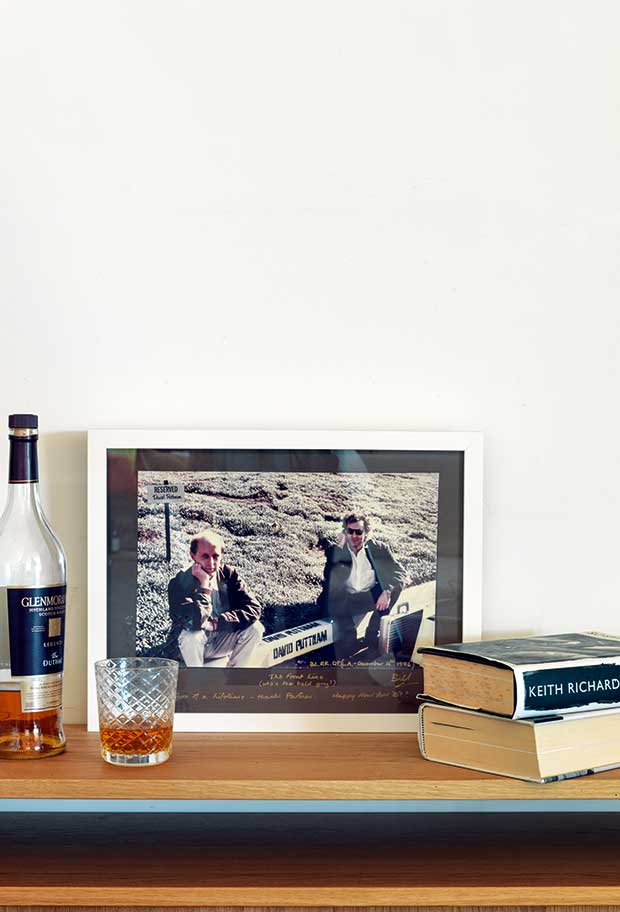
To raise funds for the R & D, they approached David Puttnam, head of Columbia Pictures, a venture capitalist who liked the ideas so much he gave them £800,000. They had some success and the pop video Love Overboard by Gladys Knight & the Pips was shot with the new Aspex camera.
But while footage could be viewed without glasses, special spectacles were still needed to amplify the effect. This limited the audience (the BBC, for instance, was concerned and would not shoot with the camera). After three years, Aspex was abandoned.
RON ON DESIGN
When Ron started Bob & Friends, he took as his style muse the original Conran shop in Chelsea.
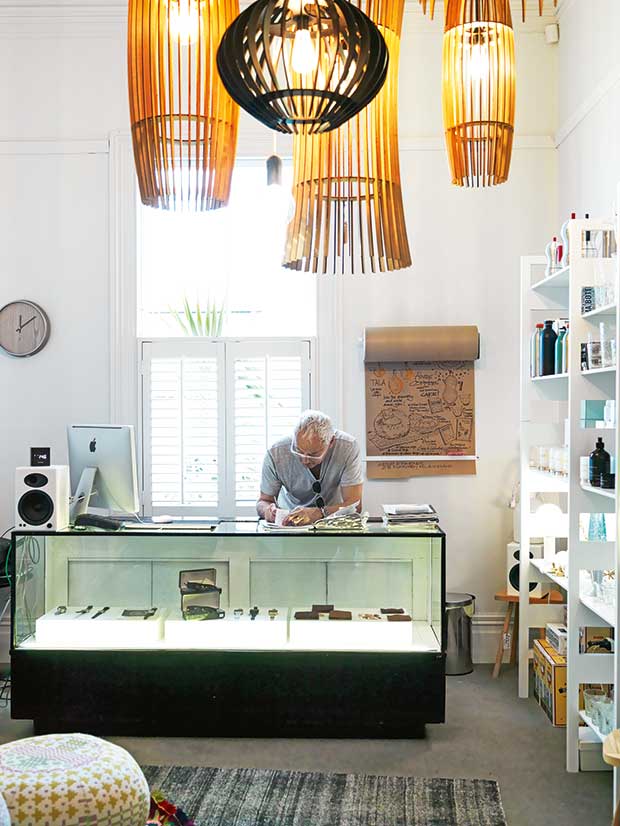
“I’ve tried to bring that flavour here. They sell the classics but aren’t monochromatic — there’s a good measure of colour. While they acknowledge trends, you’d never find chairs you can’t even sit on. It’s not furniture as art. Their focus is on comfortable, beautiful and modern.”
For those loving interior design, he also recommends a visit to Modernica in Los Angeles, Merci in Paris and SCP in Hackney, London.
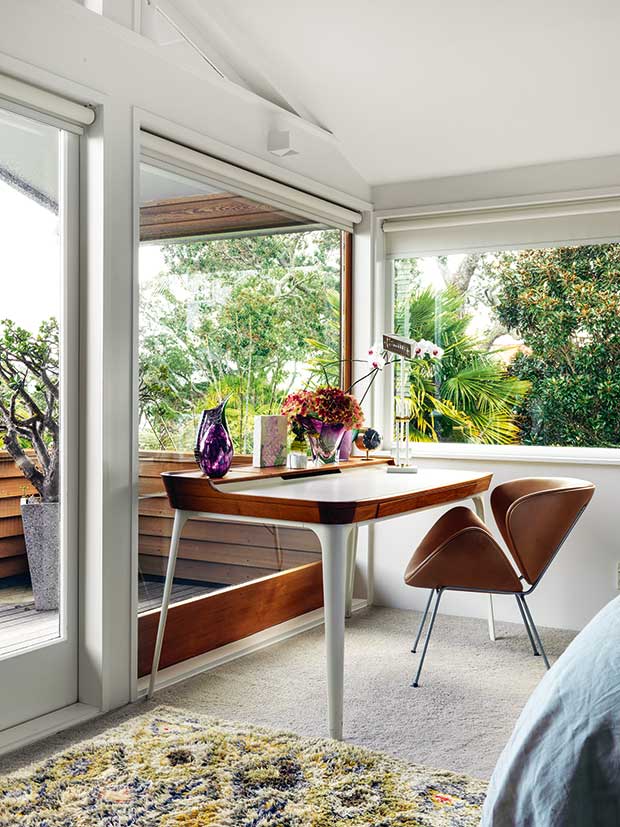
An Aria desk by Herman Miller in the master bedroom isn’t used for work but as a place to contemplate the view of Cox’s Bay.
Ron is a staunch advocate of the democratization of design. Labels such as Zara and H&M have done it for fashion, and now Ikea and Kmart are doing it for homewares, he says.
“You have to be selective. But I love Kmart’s stoneware bowls and plates. And, when I was in Spain recently, I bought a set of knives from Ikea that is just great.”
Love this story? Subscribe now!
 This article first appeared in NZ Life & Leisure Magazine.
This article first appeared in NZ Life & Leisure Magazine.

